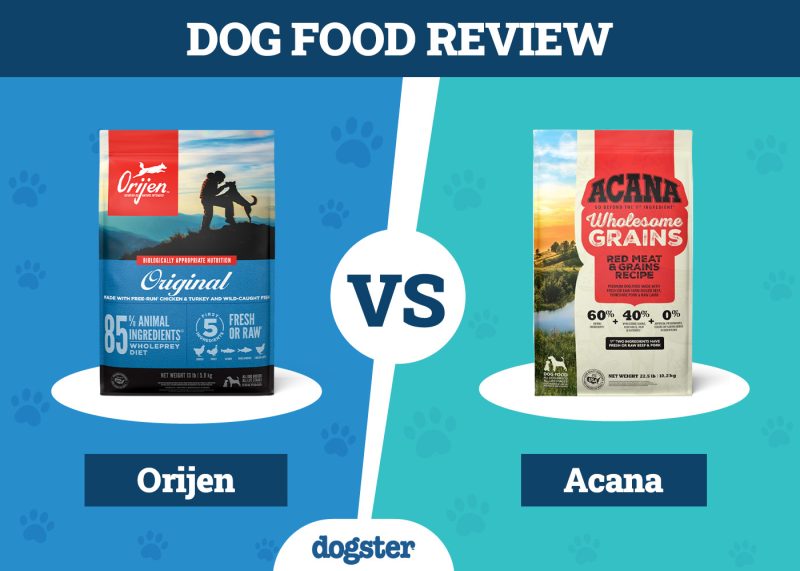In this article
Note: This article’s statistics come from third-party sources and do not represent the opinions of this website.
The pet food industry in Canada is booming right now, and when you consider how much Canadians love their pets, it’s certainly not hard to see why. Not only do some of the biggest pet food brands in the industry call Canada home, but the Canadian pet food market is expected to continue to see astronomical growth, at least for the next five years or so. Read on to find 20 fascinating statistics on the state of the Canadian pet food industry this year.

The 20 Canada Pet Food Industry Statistics
- The Canadian pet food market is expected to grow to 5.96 billion USD by 2029.
- The Canadian pet food market size was $3.34 billion USD in 2021.
- The Canadian pet nutraceutical and supplement industry is the fastest-growing market by product, with a projected CAGR of 9.06%.
- Dog food is the largest pet food category in Canada, with a value of $2.08 billion USD.
- Canadian dog owners spend approximately $1,200 CAD annually on food.
- Canadian cat owners spend approximately $576 CAD annually on food.
- Mars Incorporated is the leading market player, with a 22.53% market share as of 2022.
- There were 135 animal food manufacturing establishments in Ontario as of December 2022.
- Pedigree is the top-selling brand of pet food in Canada, valued at $190.3 million.
- The leading pet food company headquartered in Canada is Champion Petfoods, with $200 million in sales in 2022.
- Pet food imports were valued at 1,638.4 million in 2022.
- The top export market for Canadian pet food in 2023 was the United States, with $374.4 million.
- The export of Canadian pet food to China halved between 2021 and 2022.
- Over 95% of the imported pet food arriving in Canada comes from the United States.
- In April 2024, Canada’s exports of dog and cat food accounted for up to $91.5 million, and imports totaled $159 million.
- Canada’s pet food imports are expected to reach approximately 284 million kilograms by 2028.
- Canada’s pet food exports are expected to be around 305 million kilograms by 2028.
- Pet food sales account for 12% to 15% of veterinary hospitals’ total revenue in Canada.
- Dry dog food accounted for 75% of the dog food sales in Canada in 2021.
- Dry cat food accounted for 61% of all cat food sales in Canada in 2021.

The Canadian Pet Food Market
1. The Canadian pet food market is expected to grow to 5.96 billion USD by 2029.
(Mordor Intelligence)
The Canadian pet food market’s compound annual growth rate is estimated to increase by 4.47% between 2024 and 2029.

2. The Canadian pet food market size was $3.34 billion USD in 2021.
(Research and Markets)
The Canadian pet food market was $3.34 billion USD in 2021, and distribution was primarily through store-based retail channels.
3. The Canadian pet nutraceutical and supplement industry is the fastest-growing market by product, with a projected CAGR of 9.06%.
(Mordor Intelligence)
Canada has been experiencing an increased demand for pet supplements and nutraceuticals since 2017, with the most significant jump in expenditure occurring between 2019 and 2020.
4. Dog food is the largest pet food category in Canada, with a value of $2.08 billion USD.
(Expert Market Research)
Though Canadians own fewer dogs than cats, dogs still lead the pet food industry in the country. This may be due to the fact that dogs eat more commercial food than their feline counterparts, as well as the growing interest of Canadian pet owners in higher-end dog foods, like grain-free diets.

5. Canadian dog owners spend approximately $1,200 CAD annually on food.
(Statista)
A Canadian dog owner spends more on their pet’s food than any other expense ($1,200). The closest expensive is pet insurance ($1,160) and then dental cleanings ($743).
6. Canadian cat owners spend approximately $576 CAD annually on food.
(Statista)
Canadian pet owners spend much less annually on their pets’ food than dog owners. The most significant expense for cat owners is dental cleanings ($743), followed by pet insurance ($638) and food ($576).

Players in the Canadian Pet Food Market
(Mordor Intelligence)
Mars Incorporated is an American pet food manufacturer and the market leader in the Canadian pet food market, with a 22.53% market share. The other top four markets include General Mills Inc., Schell & Kampeter, Nestle, and Colgate-Palmolive Company.
8. There were 135 animal food manufacturing establishments in Ontario as of December 2022.
(Statista)
Quebec has 104 animal food manufacturing establishments, followed by British Columbia, with 59. Newfoundland and Labrador have just one.

9. Pedigree is the top-selling brand of pet food in Canada, valued at $190.3 million.
(Expert Market Research)
Canadians love their Pedigree pet food, which makes sense considering that Mars, Inc., the leading market player in the Canadian pet food market, owns Pedigree.
10. The leading pet food company headquartered in Canada is Champion Petfoods, with $200 million in sales in 2022.
(Statista)
Champion Petfoods was founded in a small town in Alberta but now sells its products in over 90 countries. The manufacturer’s line-up includes brands such as Orijen and Acana. The two Canadian-based pet food companies with the closest sales to Champion Petfoods are PLB International and FirstMate Pet Foods, both with $50 million in sales in 2022.

Imports & Exports
11. Pet food imports were valued at 1,638.4 million in 2022.
(Government of Alberta)
Data suggests that the importation of Canadian dog and cat food has increased dramatically, thanks to a growing demand for pet food in the country. Imports were valued at 1,638.4 million in 2022, a huge 22.8% increase from the year prior and a 54% increase from 2019.
12. The top export market for Canadian pet food in 2023 was the United States, with $374.4 million.
(Global Pet Industry)
This is a slight increase from 2022, when Canada exported $363.3 million to the U.S., and a significant increase from 2021, when $311.4 million was exported.
13. The export of Canadian pet food to China halved between 2021 and 2022.
(Global Pet Industry)
While Canada is exporting more food to the U.S. than ever before, the same cannot be said for all their trading partners. Canada exported just $35.1 million to China in 2023, compared to $86.1 million in 2022 and $170 million in 2021.

14. Over 95% of the imported pet food arriving in Canada comes from the United States.
(Pet Food Association of Canada)
The majority of pet food imported into Canada comes from the United States ($1.5 billion). Thailand is Canada’s next most significant importer, with $86 million, followed by China with $24 million.
15. In April 2024, Canada’s exports of dog and cat food accounted for up to $91.5 million, and imports totaled $159 million.
(Observatory of Economic Complexity)
Between April 2023 and April 2024, Canada’s exports of dog or cat food have increased by 10.1%, up to $91.5 million from $83.1 million.
16. Canada’s pet food imports are expected to reach approximately 284 million kilograms by 2028.
(Report Linker)
Canada’s pet food imports are projected to reach around 284 million kilograms by 2028, up from the 277 million kilograms imported in 2023. This is an average annual growth of 0.4%.
17. Canada’s pet food exports are expected to be around 305 million kilograms by 2028
(Report Linker)
Canada is expected to export approximately 305 million kilograms by 2028, up from 271 million kilograms exported in 2023. This is an average annual growth of 1.8%.


Pet Food Sales in Canada
18. Pet food sales account for 12% to 15% of veterinary hospitals’ total revenue in Canada.
(NCBI)
Canadian veterinarians focus more on nutrition and diet sales than their American counterparts. Pet food sales at U.S. veterinary hospitals account for only 2% to 4% of their total revenue.
19. Dry dog food accounted for 75% of the dog food sales in Canada in 2021.
(Government of Alberta)
Dog food is the largest pet food category, with a market share of 65.4% in 2022. Dog treats and mixers accounted for 18% of all dog food sales, and wet dog food accounted for just 7%.
20. Dry cat food accounted for 61% of all cat food sales in Canada in 2021.
(Government of Alberta)
Cat food is the second biggest pet food category, with a market share of 32.7% in 2020. Wet cat food accounted for 28% of all cat food sales, and cat treats and mixers accounted for 11%.


Frequently Asked Questions
What are some Canada-based pet food manufacturers?
Some of the most popular Canada-based pet food manufacturers include Champion Petfoods, FirstMate Pet Foods, PLB International, Elmira Pet Products, Hagen Pet Foods, and Petcurean Pet Nutrition.
Is the Canadian pet food industry regulated?
Yes, absolutely. All Canadian pet food manufacturers are subject to Canadian and international regulations. These safeguard animal health and ensure that no specified risk materials (SRMs) are fed to pets.
Canadian manufacturers must also comply with the Consumer Packaging and Labeling Act and the Competition Act, which specify how the pet foods they create can be marketed to consumers.
What about other pets?
While cats and dogs are by far the most popular pets in Canada, plenty of people still choose to own tropical fish, pocket pets like guinea pigs and rodents, and birds. Retail food sales for other non-canine and non-feline pets have grown slowly and steadily.
Though we don’t have updated statistics, according to stats from 202, Canadians were spending $26.8 million on fish food, $30.6 million on bird food, and $15 million on food for their pocket pets and reptiles.
(Government of Alberta)

Final Thoughts
The pet food industry in Canada is growing and is projected to continue to expand in the foreseeable future. Only time will tell what the country’s export and import stats will look like in the next few years, but we’re excited to revisit this article in the future to see how much the Canadian pet food industry has expanded.



















